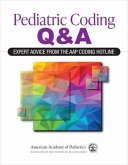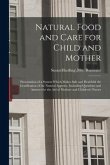American Academ
Pediatric Collections: Food Insecurity
Herausgeber: American Academy of Pediatrics (Aap)
American Academ
Pediatric Collections: Food Insecurity
Herausgeber: American Academy of Pediatrics (Aap)
- Broschiertes Buch
- Merkliste
- Auf die Merkliste
- Bewerten Bewerten
- Teilen
- Produkt teilen
- Produkterinnerung
- Produkterinnerung
Food insecurity is a significant social determinant of health and has a negative effect on health across all stages of life, leading to adverse psychosocial and physical health outcomes. Pediatric Collections: Food Insecurity was created specifically for pediatric clinicians and healthcare professionals to address food insecurity within clinical environments. Order now to learn about numerous intervention practices available that can be easily scaled and adopted within your practice and community.
Andere Kunden interessierten sich auch für
![Pediatric Collections: Adolescent Health Care: Part 2: Reproductive Health Pediatric Collections: Adolescent Health Care: Part 2: Reproductive Health]() American AcademPediatric Collections: Adolescent Health Care: Part 2: Reproductive Health46,99 €
American AcademPediatric Collections: Adolescent Health Care: Part 2: Reproductive Health46,99 €![Pediatric Telehealth Best Practices Pediatric Telehealth Best Practices]() American Academy of Pediatrics (Aap)Pediatric Telehealth Best Practices65,99 €
American Academy of Pediatrics (Aap)Pediatric Telehealth Best Practices65,99 €![Pediatric Coding Q&a: Expert Advice from the Aap Coding Hotline Pediatric Coding Q&a: Expert Advice from the Aap Coding Hotline]() American Academy of Pediatrics (Aap)Pediatric Coding Q&a: Expert Advice from the Aap Coding Hotline65,99 €
American Academy of Pediatrics (Aap)Pediatric Coding Q&a: Expert Advice from the Aap Coding Hotline65,99 €![Pediatric Neurology Pediatric Neurology]() Pediatric Neurology108,99 €
Pediatric Neurology108,99 €![Natural Food and Care for Child and Mother: Presentation of a System Which Makes Safe and Healthful the Gratification of the Natural Appetite, Includi Natural Food and Care for Child and Mother: Presentation of a System Which Makes Safe and Healthful the Gratification of the Natural Appetite, Includi]() Natural Food and Care for Child and Mother: Presentation of a System Which Makes Safe and Healthful the Gratification of the Natural Appetite, Includi22,99 €
Natural Food and Care for Child and Mother: Presentation of a System Which Makes Safe and Healthful the Gratification of the Natural Appetite, Includi22,99 €![Oral Manifestations of Pediatric Cancers and Its Management Oral Manifestations of Pediatric Cancers and Its Management]() Ankur JainOral Manifestations of Pediatric Cancers and Its Management24,99 €
Ankur JainOral Manifestations of Pediatric Cancers and Its Management24,99 €![Naspag Essentials of Pediatric and Adolescent Gynecology Naspag Essentials of Pediatric and Adolescent Gynecology]() Nirupama de SilvaNaspag Essentials of Pediatric and Adolescent Gynecology102,99 €
Nirupama de SilvaNaspag Essentials of Pediatric and Adolescent Gynecology102,99 €-
-
-
Food insecurity is a significant social determinant of health and has a negative effect on health across all stages of life, leading to adverse psychosocial and physical health outcomes. Pediatric Collections: Food Insecurity was created specifically for pediatric clinicians and healthcare professionals to address food insecurity within clinical environments. Order now to learn about numerous intervention practices available that can be easily scaled and adopted within your practice and community.
Produktdetails
- Produktdetails
- Verlag: American Academy of Pediatrics
- Seitenzahl: 225
- Erscheinungstermin: 10. März 2025
- Englisch
- Abmessung: 274mm x 206mm x 15mm
- Gewicht: 599g
- ISBN-13: 9781610028110
- ISBN-10: 1610028112
- Artikelnr.: 73895321
- Herstellerkennzeichnung
- Libri GmbH
- Europaallee 1
- 36244 Bad Hersfeld
- gpsr@libri.de
- Verlag: American Academy of Pediatrics
- Seitenzahl: 225
- Erscheinungstermin: 10. März 2025
- Englisch
- Abmessung: 274mm x 206mm x 15mm
- Gewicht: 599g
- ISBN-13: 9781610028110
- ISBN-10: 1610028112
- Artikelnr.: 73895321
- Herstellerkennzeichnung
- Libri GmbH
- Europaallee 1
- 36244 Bad Hersfeld
- gpsr@libri.de
The American Academy of Pediatrics is an organization of 67,000 primary care pediatricians, pediatric medical subspecialists and pediatric surgical specialists dedicated to the health, safety and well-being of infants, children, adolescents and young adults. The AAP is the largest pediatric publisher in the world, with a diverse list of resources that includes essential clinical and practice management titles and award-winning books for parents.
Introduction by Kimberly Montez, MD, MPH, FAAP
1. Community-Led Interventions to Address Food Inequity
2. Farm to Families: Clinic-based Produce Provision to Address Food
Insecurity During the Pandemic
3. Accuracy of a Single Financial Security Question to Screen for Social
Needs
4. Food Insecurity Screening of Hospitalized Patients: A Descriptive
Analysis
5. Evaluating Screening to Assess Endorsement of Food Insecurity in the
Inpatient Setting
6. Quality Improvement to Identify and Address Food Insecurity During
Pediatric Hospitalizations
7. Progress and Potential: Addressing Food Insecurity in Caregivers of
Hospitalized Children
8. Disparities and Biases in Food Insecurity Screening Among Admitted
Children
9. Food Insecurity and Experiences of Discrimination Among Caregivers of
Hospitalized Children
10. Reducing Caregiver Hunger During Pediatric Hospitalization
11. Food Insecurity and Community-Based Food Resources Among Caregivers
of Hospitalized Children
12. Addressing Food Insecurity Among Hospitalized Children: Upstream and
Downstream Approaches
13. Identifying Food Insecurity in Cardiology Clinic and Connecting
Families to Resources
14. Establishing a Permanent Food Pantry in a Pediatric Emergency
Department
15. SNAP Participation and Emergency Department Use
16. Perspectives From Urban WIC-Eligible Caregivers to Improve Produce
Access
17. Caregiver Perspectives on Improving Government Nutrition Benefit
Programs
18. Caregiver Perspectives on Underutilization of WIC: A Qualitative
Study
19. Assessing and Improving WIC Enrollment in the Primary Care Setting: A
Quality Initiative
20. Health Care as a Partner in Federal Nutrition Programs: Call for
Advocacy
21. Cost-effectiveness of Improved WIC Food Package for Preventing
Childhood Obesity
22. Trends in Severe Obesity Among Children Aged 2 to 4 Years in WIC:
2010 to 2020
23. Universal Free School Meals Policy and Childhood Obesity
24. Food Insecurity and Childhood Obesity: A Systematic Review
25. Food Insecurity and Cardiometabolic Markers: Results From the Study
of Latino Youth
26. Pediatric Formulas: An Update
1. Community-Led Interventions to Address Food Inequity
2. Farm to Families: Clinic-based Produce Provision to Address Food
Insecurity During the Pandemic
3. Accuracy of a Single Financial Security Question to Screen for Social
Needs
4. Food Insecurity Screening of Hospitalized Patients: A Descriptive
Analysis
5. Evaluating Screening to Assess Endorsement of Food Insecurity in the
Inpatient Setting
6. Quality Improvement to Identify and Address Food Insecurity During
Pediatric Hospitalizations
7. Progress and Potential: Addressing Food Insecurity in Caregivers of
Hospitalized Children
8. Disparities and Biases in Food Insecurity Screening Among Admitted
Children
9. Food Insecurity and Experiences of Discrimination Among Caregivers of
Hospitalized Children
10. Reducing Caregiver Hunger During Pediatric Hospitalization
11. Food Insecurity and Community-Based Food Resources Among Caregivers
of Hospitalized Children
12. Addressing Food Insecurity Among Hospitalized Children: Upstream and
Downstream Approaches
13. Identifying Food Insecurity in Cardiology Clinic and Connecting
Families to Resources
14. Establishing a Permanent Food Pantry in a Pediatric Emergency
Department
15. SNAP Participation and Emergency Department Use
16. Perspectives From Urban WIC-Eligible Caregivers to Improve Produce
Access
17. Caregiver Perspectives on Improving Government Nutrition Benefit
Programs
18. Caregiver Perspectives on Underutilization of WIC: A Qualitative
Study
19. Assessing and Improving WIC Enrollment in the Primary Care Setting: A
Quality Initiative
20. Health Care as a Partner in Federal Nutrition Programs: Call for
Advocacy
21. Cost-effectiveness of Improved WIC Food Package for Preventing
Childhood Obesity
22. Trends in Severe Obesity Among Children Aged 2 to 4 Years in WIC:
2010 to 2020
23. Universal Free School Meals Policy and Childhood Obesity
24. Food Insecurity and Childhood Obesity: A Systematic Review
25. Food Insecurity and Cardiometabolic Markers: Results From the Study
of Latino Youth
26. Pediatric Formulas: An Update
Introduction by Kimberly Montez, MD, MPH, FAAP
1. Community-Led Interventions to Address Food Inequity
2. Farm to Families: Clinic-based Produce Provision to Address Food
Insecurity During the Pandemic
3. Accuracy of a Single Financial Security Question to Screen for Social
Needs
4. Food Insecurity Screening of Hospitalized Patients: A Descriptive
Analysis
5. Evaluating Screening to Assess Endorsement of Food Insecurity in the
Inpatient Setting
6. Quality Improvement to Identify and Address Food Insecurity During
Pediatric Hospitalizations
7. Progress and Potential: Addressing Food Insecurity in Caregivers of
Hospitalized Children
8. Disparities and Biases in Food Insecurity Screening Among Admitted
Children
9. Food Insecurity and Experiences of Discrimination Among Caregivers of
Hospitalized Children
10. Reducing Caregiver Hunger During Pediatric Hospitalization
11. Food Insecurity and Community-Based Food Resources Among Caregivers
of Hospitalized Children
12. Addressing Food Insecurity Among Hospitalized Children: Upstream and
Downstream Approaches
13. Identifying Food Insecurity in Cardiology Clinic and Connecting
Families to Resources
14. Establishing a Permanent Food Pantry in a Pediatric Emergency
Department
15. SNAP Participation and Emergency Department Use
16. Perspectives From Urban WIC-Eligible Caregivers to Improve Produce
Access
17. Caregiver Perspectives on Improving Government Nutrition Benefit
Programs
18. Caregiver Perspectives on Underutilization of WIC: A Qualitative
Study
19. Assessing and Improving WIC Enrollment in the Primary Care Setting: A
Quality Initiative
20. Health Care as a Partner in Federal Nutrition Programs: Call for
Advocacy
21. Cost-effectiveness of Improved WIC Food Package for Preventing
Childhood Obesity
22. Trends in Severe Obesity Among Children Aged 2 to 4 Years in WIC:
2010 to 2020
23. Universal Free School Meals Policy and Childhood Obesity
24. Food Insecurity and Childhood Obesity: A Systematic Review
25. Food Insecurity and Cardiometabolic Markers: Results From the Study
of Latino Youth
26. Pediatric Formulas: An Update
1. Community-Led Interventions to Address Food Inequity
2. Farm to Families: Clinic-based Produce Provision to Address Food
Insecurity During the Pandemic
3. Accuracy of a Single Financial Security Question to Screen for Social
Needs
4. Food Insecurity Screening of Hospitalized Patients: A Descriptive
Analysis
5. Evaluating Screening to Assess Endorsement of Food Insecurity in the
Inpatient Setting
6. Quality Improvement to Identify and Address Food Insecurity During
Pediatric Hospitalizations
7. Progress and Potential: Addressing Food Insecurity in Caregivers of
Hospitalized Children
8. Disparities and Biases in Food Insecurity Screening Among Admitted
Children
9. Food Insecurity and Experiences of Discrimination Among Caregivers of
Hospitalized Children
10. Reducing Caregiver Hunger During Pediatric Hospitalization
11. Food Insecurity and Community-Based Food Resources Among Caregivers
of Hospitalized Children
12. Addressing Food Insecurity Among Hospitalized Children: Upstream and
Downstream Approaches
13. Identifying Food Insecurity in Cardiology Clinic and Connecting
Families to Resources
14. Establishing a Permanent Food Pantry in a Pediatric Emergency
Department
15. SNAP Participation and Emergency Department Use
16. Perspectives From Urban WIC-Eligible Caregivers to Improve Produce
Access
17. Caregiver Perspectives on Improving Government Nutrition Benefit
Programs
18. Caregiver Perspectives on Underutilization of WIC: A Qualitative
Study
19. Assessing and Improving WIC Enrollment in the Primary Care Setting: A
Quality Initiative
20. Health Care as a Partner in Federal Nutrition Programs: Call for
Advocacy
21. Cost-effectiveness of Improved WIC Food Package for Preventing
Childhood Obesity
22. Trends in Severe Obesity Among Children Aged 2 to 4 Years in WIC:
2010 to 2020
23. Universal Free School Meals Policy and Childhood Obesity
24. Food Insecurity and Childhood Obesity: A Systematic Review
25. Food Insecurity and Cardiometabolic Markers: Results From the Study
of Latino Youth
26. Pediatric Formulas: An Update








